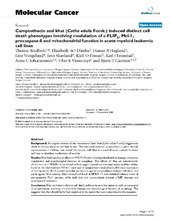Camptothecin and khat (Catha edulis Forsk.) induced distinct cell death phenotypes involving modulation of c-FLIPL, Mcl-1, procaspase-8 and mitochondrial function in acute myeloid leukemia cell lines
Bredholt, Therese; Dimba, Elizabeth A. O.; Hagland, Hanne; Wergeland, Line; Skavland, Jørn; Fossan, Kjell Ove; Tronstad, Karl Johan; Johannessen, Anne Christine; Vintermyr, Olav Karsten; Gjertsen, Bjørn Tore
Peer reviewed, Journal article
Permanent lenke
https://hdl.handle.net/1956/4182Utgivelsesdato
2009-11-13Metadata
Vis full innførselSamlinger
- Department of Biomedicine [710]
- Department of Clinical Science [2318]
Originalversjon
https://doi.org/10.1186/1476-4598-8-101Sammendrag
Background: An organic extract of the recreational herb khat (Catha edulis Forsk.) triggers cell death in various leukemia cell lines in vitro. The chemotherapeutics camptothecin, a plant alkaloid topoisomerase I inhibitor, was tested side-by-side with khat in a panel of acute myeloid leukemia cell lines to elucidate mechanisms of toxicity. Results: Khat had a profound effect on MOLM-13 cells inducing mitochondrial damage, chromatin margination and morphological features of autophagy. The effects of khat on mitochondrial ultrastructure in MOLM-13 correlated with strongly impaired routine respiration, an effect neither found in the khat-resistant MV-4-11 cells nor in camptothecin treated cells. Enforced expression of anti-apoptotic Bcl-2 protein provided protection against camptothecin-induced cell death and partly against khat toxicity. Khat-induced cell death in MOLM-13 cells included reduced levels of anti-apoptotic Mcl-1 protein, while both khat and camptothecin induced c-FLIPL cleavage and procaspase-8 activation. Conclusion: Khat activated a distinct cell death pathway in sensitive leukemic cells as compared to camptothecin, involving mitochondrial damage and morphological features of autophagy. This suggests that khat should be further explored in the search for novel experimental therapeutics.
Utgiver
BioMed CentralOpphavsrett
Copyright 2009 Bredholt et al; licensee BioMed CentralBredholt et al; licensee BioMed Central

